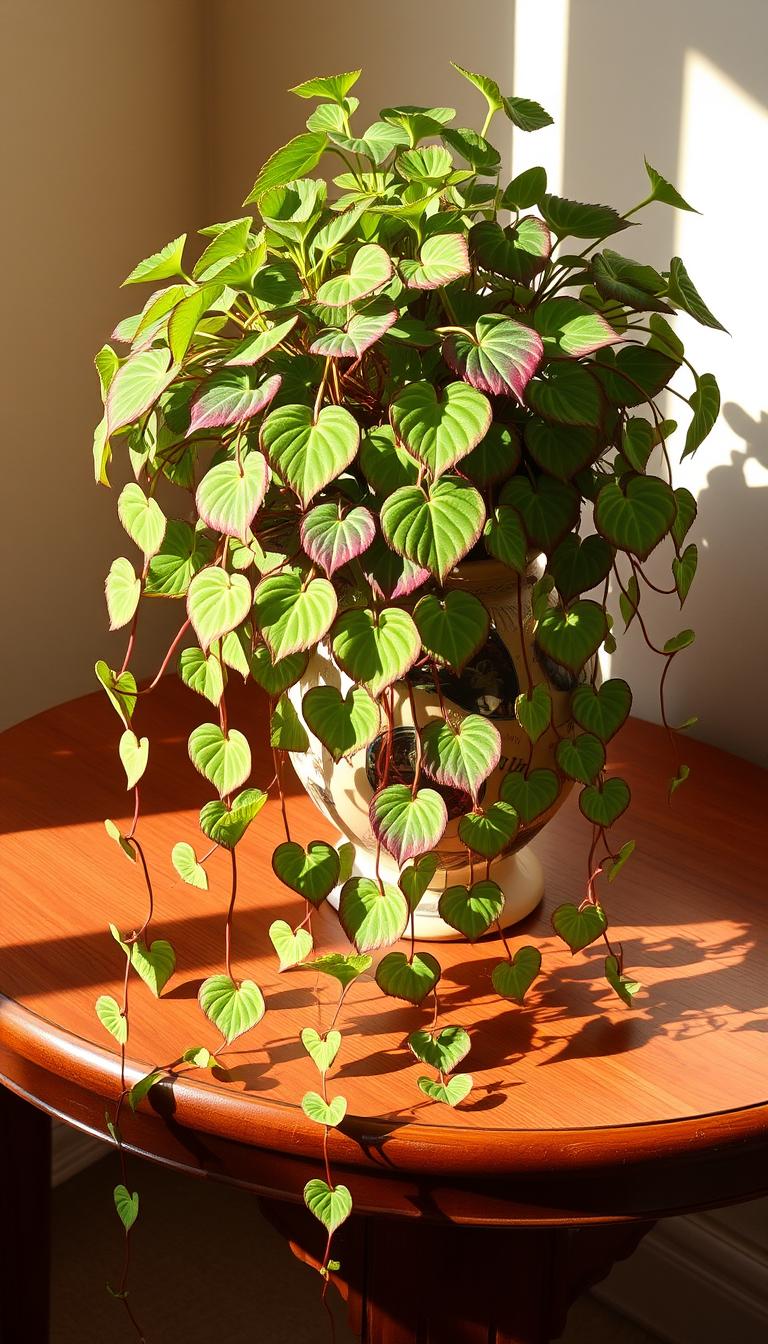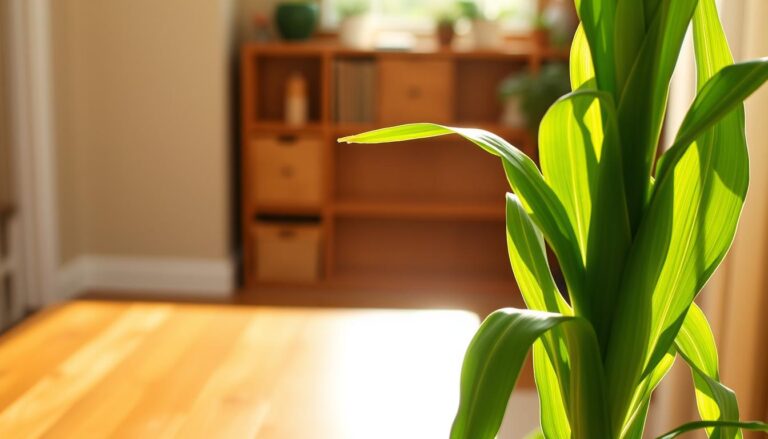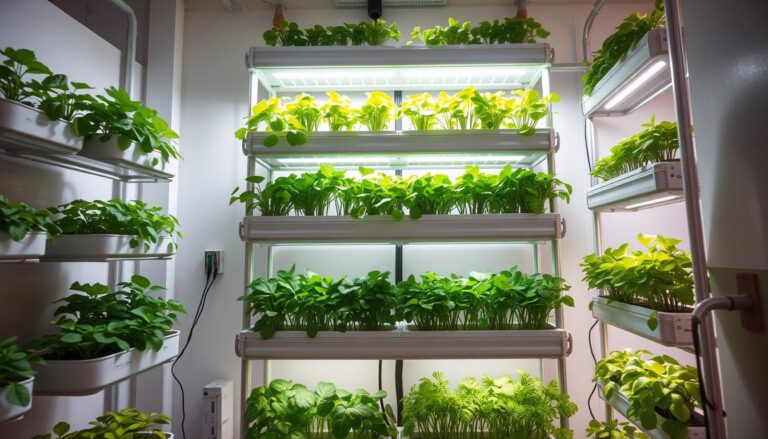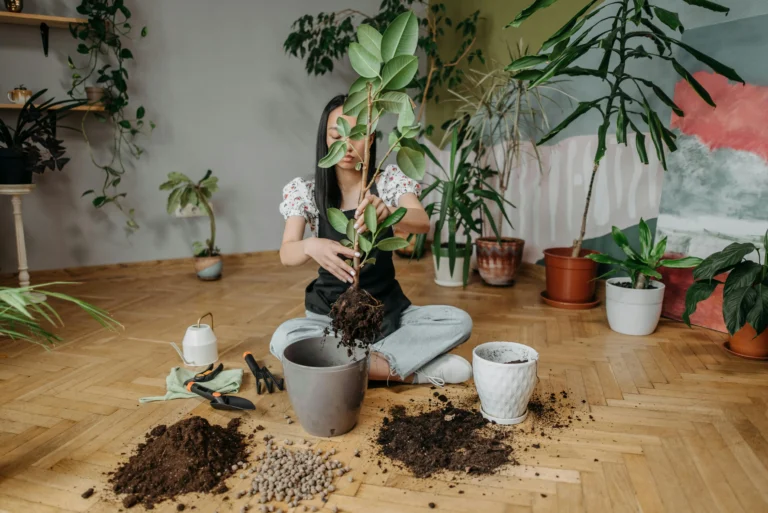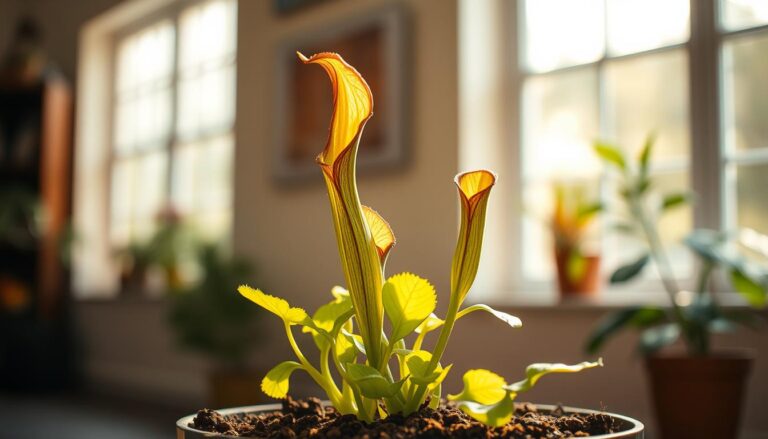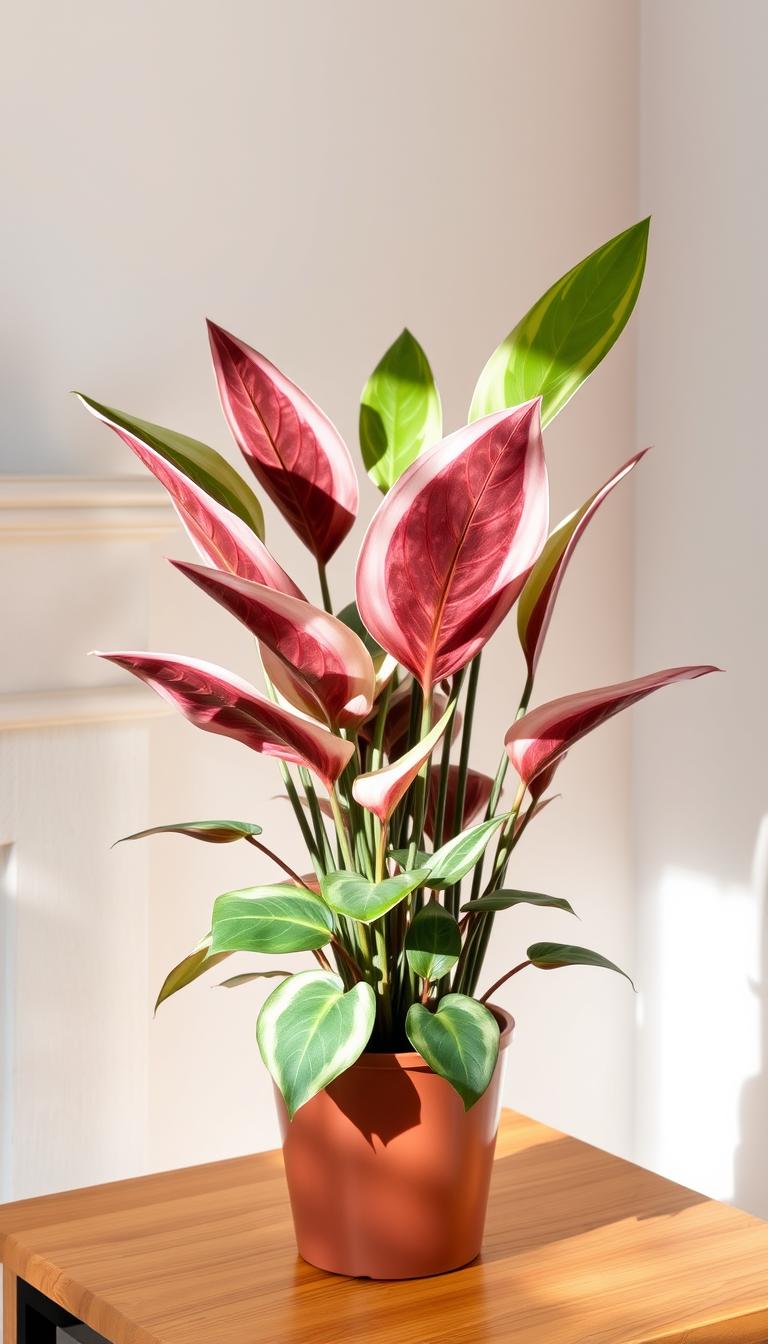The Traveling Jew Plant: A Fascinating Houseplant to Grow
Have you ever walked into a room and felt instantly drawn to a splash of color cascading from a windowsill? That’s the magic of the traveling jew plant. With its striking purple-and-green leaves, this vibrant houseplant isn’t just decor—it’s a living work of art that thrives with minimal effort.
Often called the wandering variety, this plant belongs to the Tradescantia family. Its unique name reflects its trailing growth habit, as if it’s “exploring” your space. Whether you’re a seasoned gardener or a first-time plant parent, its adaptability makes it a perfect fit for busy lifestyles.
In this guide, you’ll discover how to keep your Tradescantia thriving. We’ll cover everything from sunlight preferences to watering routines. You’ll also learn creative ways to style its lush foliage, turning any corner of your home into a green oasis.
Table of Contents
Introduction to the Traveling Jew Plant
Native to Mexico and Central America, this eye-catching species thrives in warm, humid climates. Its journey from tropical forests to living rooms began centuries ago, thanks to its hardy nature and vivid foliage. Botanists and hobbyists alike admire its ability to adapt, making it a staple in modern indoor gardens.
Overview and History
The Tradescantia family, named after 17th-century botanist John Tradescant, includes over 70 species. Originally found creeping across forest floors, these plants evolved to tolerate shade and irregular watering. By the 1900s, their striking leaves and trailing stems made them a favorite for Victorian-era décor.
Common Names and Origins
While often called “wandering jew,” this nickname has roots in harmful stereotypes. Many now prefer terms like “inch plant”—referring to how quickly it grows—or “spiderwort.” Regardless of labels, its resilience and rapid spread explain why it’s cherished globally. In the wild, you’ll find it clinging to rocks or climbing trees, a trait that translates well to hanging baskets at home.
Understanding Wandering Jew Varieties
Not all trailing houseplants are created equal—some stand out with bold patterns or rich hues. Two standout tradescantia types dominate indoor gardens: Zebrina ‘Tricolor’ and Pallida ‘Purple Heart’. Each brings unique textures and colors to your space.
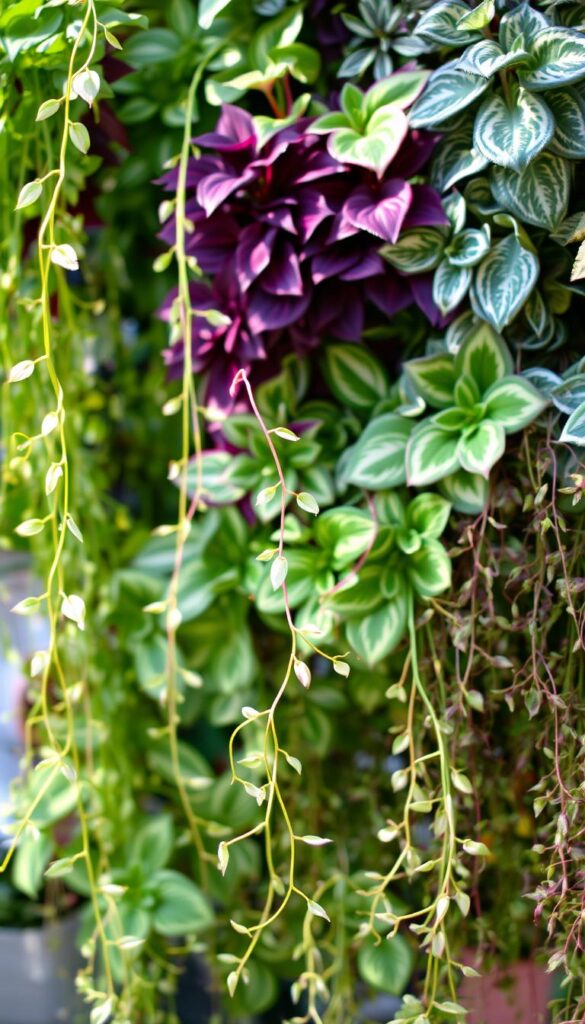
Tradescantia Zebrina ‘Tricolor’
The Zebrina ‘Tricolor’ dazzles with striped leaves in green, silver, and pink. Its oval-shaped foliage grows rapidly, producing delicate pink blooms in summer. This variety thrives in bright, indirect light, which intensifies its vibrant stripes. Use its long stems in hanging baskets for a waterfall effect.
Tradescantia Pallida ‘Purple Heart’
For drama, the Pallida ‘Purple Heart’ offers deep purple leaves that deepen in sunlight. Unlike Zebrina, its narrow foliage forms dense clusters. Hardy and drought-tolerant, it’s ideal as a ground cover outdoors or in low-maintenance setups. Tiny lavender flowers appear sporadically, adding subtle contrast.
| Feature | Zebrina ‘Tricolor’ | Pallida ‘Purple Heart’ |
|---|---|---|
| Leaf Color | Green/silver/pink stripes | Solid purple |
| Growth Habit | Fast, trailing | Compact, upright |
| Light Needs | Bright indirect | Direct or partial sun |
| Best Use | Hanging displays | Ground cover |
Both tradescantia types root easily from stems placed in water or soil. Choose Zebrina for color variety or Pallida for bold simplicity. Matching their traits to your environment ensures thriving growth.
Optimal Light Conditions for Your Houseplant
Light is the secret ingredient that transforms your houseplant from surviving to thriving. While this species adapts to various environments, its foliage shines brightest when given the right balance of illumination. East or west-facing windows often provide the ideal bright indirect light conditions—enough energy for growth without harsh midday rays.
Bright Indirect Light Benefits
Bright indirect light fuels photosynthesis while protecting delicate leaves. Direct sunlight can scorch surfaces, causing faded or bleached patches. Filtered light maintains vibrant purple and silver tones, especially in variegated varieties.
Position your greenery 3-5 feet from a sunny window. Sheer curtains or blinds help diffuse intense afternoon sun. Rotate the pot weekly to ensure even exposure—lopsided growth signals uneven lighting.
Indoor vs. Outdoor Sun Exposure
Indoor settings let you control light intensity year-round. Outdoor placements work in shaded patios but require gradual acclimation. Morning sun is gentler than harsh midday beams.
Watch for leaf curling or browning—these warn of excessive light. In winter, move pots closer to windows as daylight diminishes. Use grow lights if natural sources are limited. Balance is key: too little light weakens stems, while too much fades colors.
Choosing the Best Potting Mix and Soil Preparation
The foundation of a thriving indoor garden starts beneath the surface. For your Tradescantia, the right potting mix ensures roots breathe while retaining essential moisture. A balanced blend prevents waterlogging—a common cause of root rot.
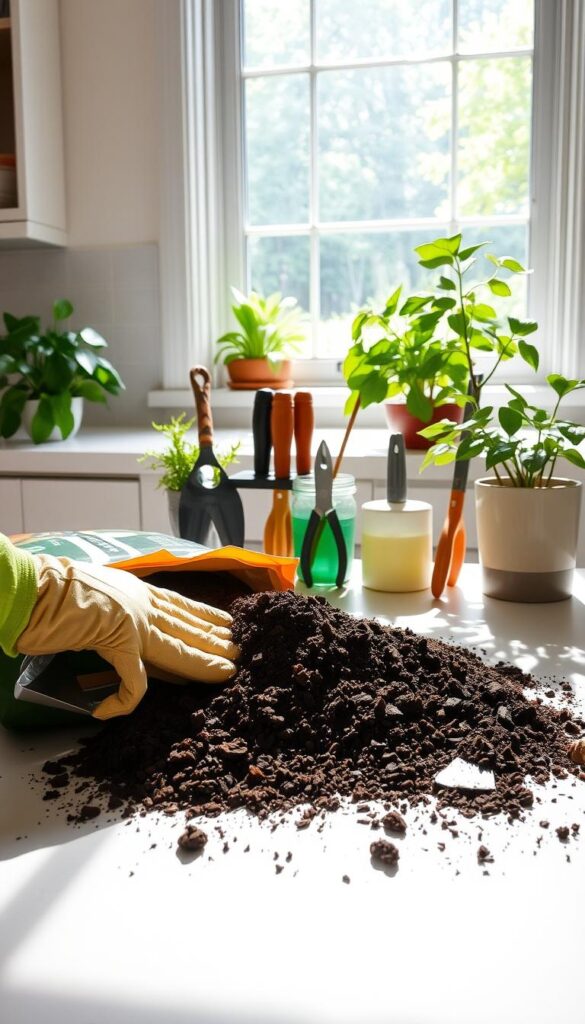
Soil Composition and pH Importance
Ideal soil combines organic compost, perlite, and peat moss. Compost enriches nutrients, perlite boosts drainage, and peat moss maintains slight acidity. Aim for a pH between 5 and 6—this range optimizes nutrient absorption.
Mix equal parts of these components for a DIY blend. Pre-made options labeled “tropical” or “houseplant” often work well. Test pH using a $10 kit from garden stores. If too alkaline, add sulfur or peat moss. Too acidic? Sprinkle lime powder.
Seasoned growers recommend adding orchid bark for extra aeration. One popular recipe: 40% compost, 30% perlite, 20% peat moss, and 10% bark. Avoid dense garden soil—it compacts easily, suffocating delicate roots.
Always use pots with drainage holes. Layer gravel at the bottom to prevent clogging. Refresh the mix every 12–18 months to maintain structure and fertility. Your Tradescantia’s vibrant growth will reward the effort.
Watering Strategies and Moisture Management
Watering your Tradescantia might seem simple, but getting it just right makes all the difference. Think of moisture management as a dance—too much or too little, and your green companion’s health falters. The key? Observing and adapting to your home’s unique environment.
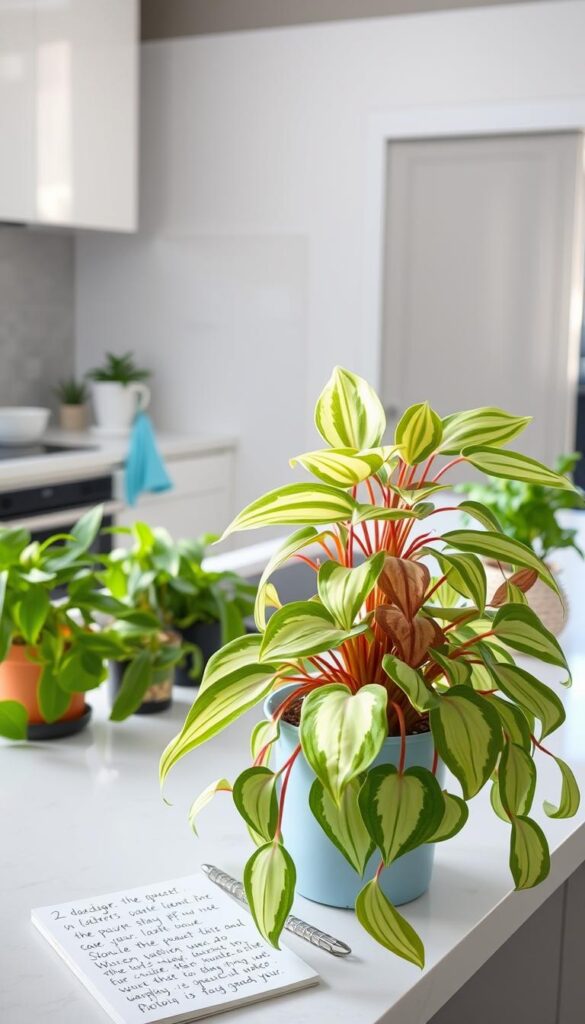
Maintaining Even Moisture Levels
Check the top ½ inch of soil with your finger. If it feels dry, it’s time to hydrate. “Consistency matters more than quantity,” says veteran gardener Lila Monroe. Use room-temperature water to avoid shocking delicate roots.
Create a flexible schedule based on your light exposure and room temperature. Homes with bright indirect light may need weekly watering, while shaded areas require less. Always empty saucers after 15 minutes to prevent soggy soil.
| Factor | Proper Watering | Overwatering |
|---|---|---|
| Soil Check | Dry top ½ inch | Constantly damp |
| Frequency | Every 7–10 days | More than weekly |
| Signs | Firm stems | Yellow leaves |
| Solution | Adjust schedule | Repot & dry roots |
Identifying Overwatering Signs
Leaves turning yellow? That’s your first clue. Soggy soil starves roots of oxygen, leading to root rot. Mushy stems or a musty odor confirm trouble. Act fast—trim damaged roots and repot in fresh mix.
Prevent future issues by choosing pots with drainage holes. Terracotta containers wick away excess moisture naturally. Remember: conditions like humidity and airflow affect drying speed. Adapt your routine seasonally for happy growth.
Fertilizing and Pruning for Vigorous Growth
Your wandering dude rewards consistent nourishment and strategic trimming with lush, dense foliage. Balancing these two practices transforms sparse stems into cascading masterpieces. Let’s explore how to optimize your routine without complexity.
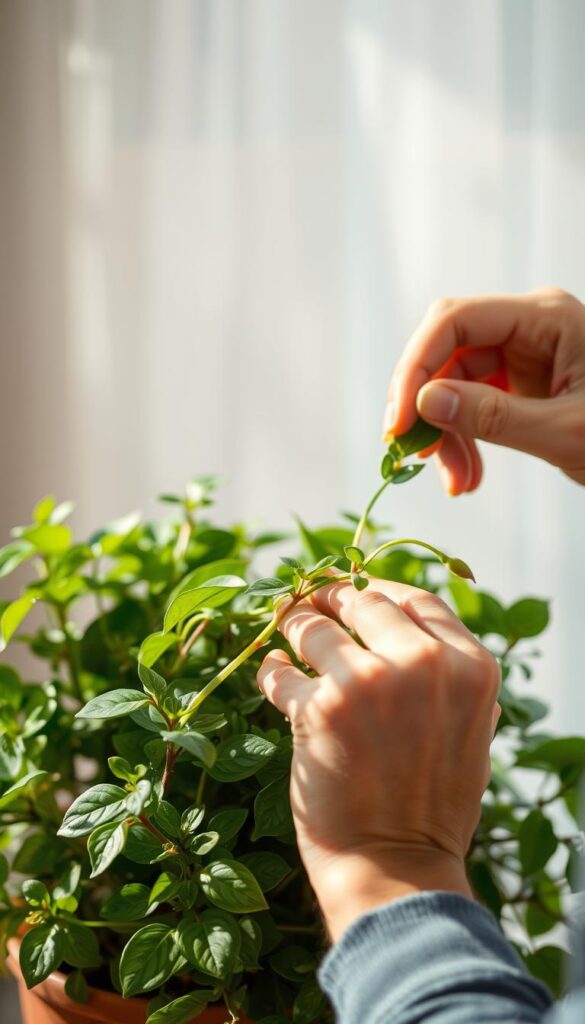
Fertilizer Schedule and Dilution Tips
Feed your houseplant monthly during spring and summer. Use a balanced 10-10-10 liquid fertilizer, diluted to half strength. Over-concentrated solutions can burn roots—always mix 1 teaspoon per gallon of water.
Skip winter feedings when growth slows. Water thoroughly before applying to prevent root shock. For organic options, try fish emulsion every 6 weeks. Watch for brighter leaf colors within 14 days—a sign your care is working.
Effective Pruning Techniques
Trim leggy stems just above leaf nodes using sanitized shears. This encourages branching, creating bushier plants. Remove yellowed or damaged sections first to redirect energy.
Prune quarterly for shape, but avoid cutting more than ⅓ of the foliage. Save healthy cuttings for propagation—they root easily in water. One gardener reported tripling her plant’s volume in 3 months through regular snipping.
Adjust both practices seasonally: fertilize less in autumn, prune minimally in winter. Your wandering dude will thrive with this rhythmic approach.
Propagating the Traveling Jew Plant
Ever wanted to multiply your greenery without a trip to the nursery? This resilient houseplant practically begs to be propagated. With just a pair of scissors and basic supplies, you’ll create new growth in days.
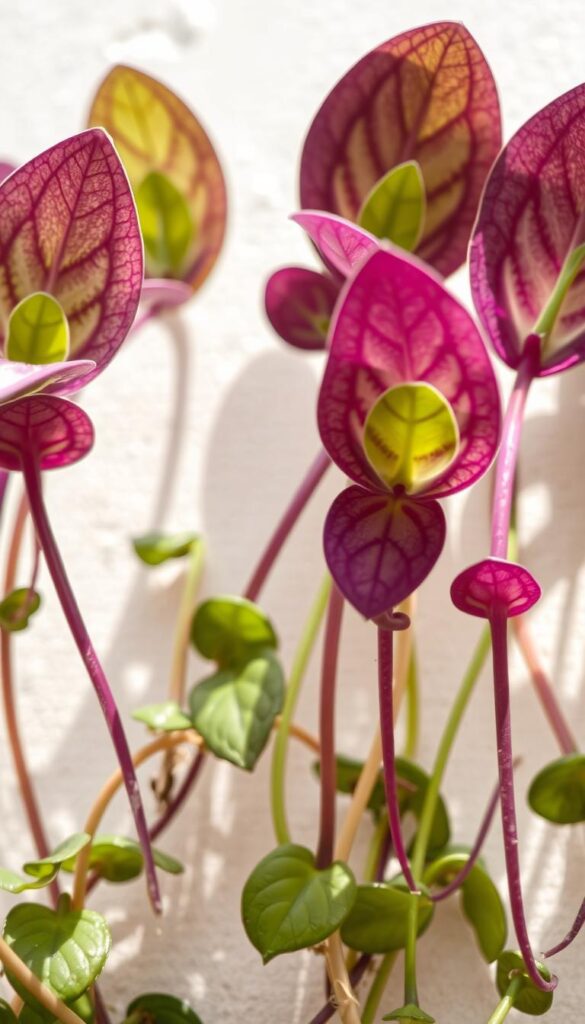
Soil Propagation Method
Snip a 4–6 inch stem just below a leaf node—the bump where leaves emerge. Remove the lower leaves to expose 1–2 nodes. Dip the end in rooting hormone (optional) and press it into moist mix. Keep the soil lightly damp, and roots will form within 10 days.
Water Propagation Approach
Place cuttings in a glass of water, ensuring nodes are submerged. Position it in bright, indirect light. Change the water every 3 days to prevent algae. You’ll see white roots sprouting in 7–14 days. Transfer to soil once roots reach 2 inches long.
Both methods work beautifully for this fast-growing inch plant. Experiment to see which fits your routine. One gardener shared: “I’ve gifted 20 plants from one mother cutting—it’s that simple!” Share extras with friends or fill empty corners with your thriving collection.
Repotting Tips and When to Upgrade Your Pot
Repotting isn’t just about size—it’s about revitalizing growth. Over time, roots can become cramped, leading to stunted development. Recognizing when your greenery needs space ensures it continues to thrive indoors.
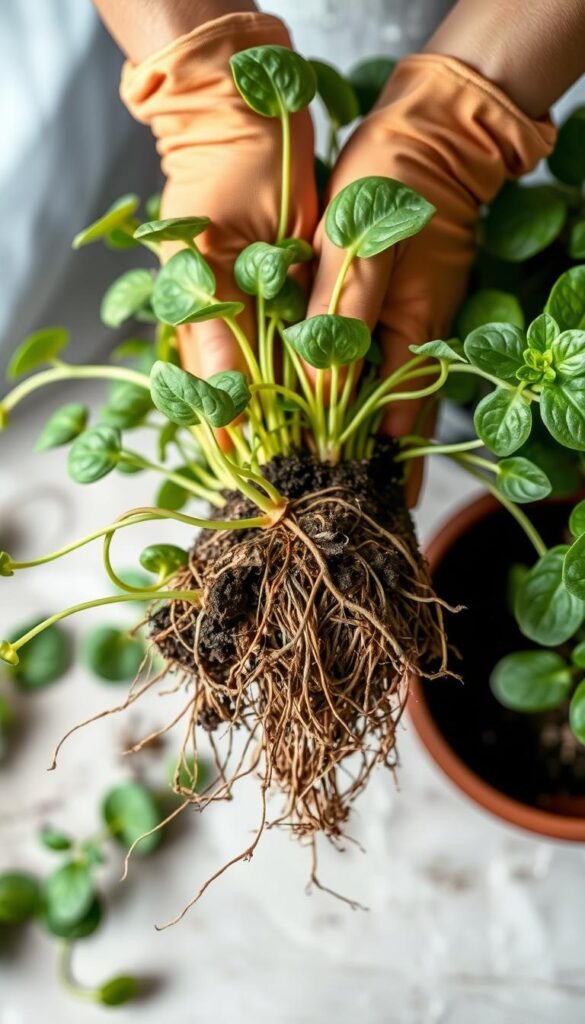
Spotting Root-Bound Signals
Check for these clues that your plant needs a new home:
- Visible roots poking through drainage holes
- Soil drying out faster than usual
- Stunted growth despite proper care
Gently slide the plant from its pot. If the roots form a tight spiral, it’s time to upgrade. Loosen the root ball with your fingers to encourage outward growth.
| Sign | Solution |
|---|---|
| Roots circling the pot | Move to a container 1–2 inches wider |
| Water pooling on top | Replace compacted soil |
| Yellowing lower leaves | Refresh nutrients with new potting mix |
Choose a pot with drainage holes and fill it ⅓ with fresh soil. Position the stem at the same depth as before. Water lightly to settle the mix, then resume normal care.
Repot every 12–18 months during spring. This timing aligns with active growth phases, reducing shock. Your refreshed greenery will reward you with vigorous new stems and leaves.
Managing Common Pests and Plant Diseases
Even the most resilient foliage can face challenges. Your wandering jew might occasionally attract unwanted visitors or develop issues if conditions aren’t ideal. Quick action and preventive habits keep your greenery thriving year-round.
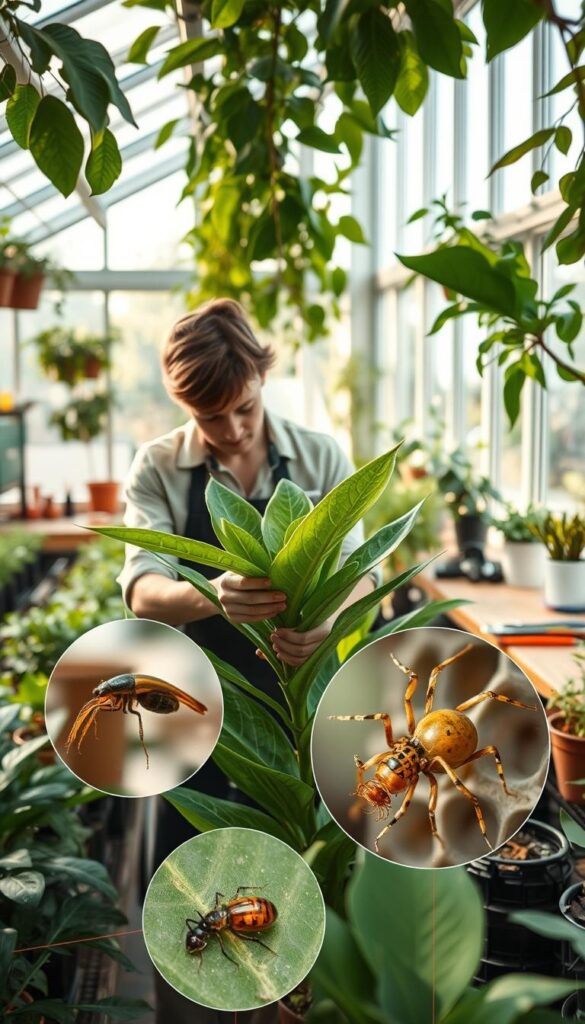
Combating Spider Mites and Aphids
Tiny spider mites leave fine webs under leaves, while aphids cluster on new growth. Both pests suck sap, causing yellow speckles or curled foliage. Wipe leaves with a damp cloth weekly to catch early signs.
For infestations, mix 1 teaspoon neem oil with 1 quart water. Spray thoroughly, focusing on leaf undersides. Repeat every 5 days until pests vanish. “Isolate affected plants immediately,” advises horticulturist Mara Lin. This prevents spreading to nearby greenery.
| Pest | Signs | Treatment |
|---|---|---|
| Spider Mites | Webbing, yellow dots | Neem oil spray |
| Aphids | Sticky residue, clusters | Insecticidal soap |
| Root Rot | Mushy stems | Soil replacement |
Prevention of Root Rot and Fungal Issues
Root rot often stems from soggy soil. Always make sure pots have drainage holes and empty saucers after watering. A gritty potting mix with perlite reduces water retention.
Trim blackened roots promptly and repot in fresh soil. Improve airflow around your wandering jew to discourage mold. If white fuzz appears on leaves, apply a baking soda solution (1 tbsp per gallon) to affected areas.
Make sure to inspect stems near leaf nodes weekly—this is where issues often start. Consistent care keeps your trailing beauty pest-free and vibrant.
Special Care and Maintenance Considerations
Your trailing foliage responds to seasonal shifts like a living barometer. As temperatures and daylight hours change, so do its needs. A few strategic tweaks to your routine keep those vibrant leaves lush through every season.
Seasonal Adjustments and Temperature Control
Winter demands careful attention. Keep your greenery away from drafty windows and heating vents. Aim for stable temperatures between 65–75°F. Reduce watering frequency since soil dries slower in cooler months.
Summer brings faster growth. Increase hydration slightly but avoid waterlogging. Shield plants from direct afternoon sun using sheer curtains. Rotate pots weekly for balanced light exposure.
| Season | Adjustment | Benefit |
|---|---|---|
| Winter | Reduce watering by 30% | Prevents root rot |
| Summer | Mist leaves twice weekly | Boosts humidity |
| Spring/Fall | Fertilize monthly | Supports new growth |
Humidity and Air Circulation Tips
These tropical natives thrive in 40–60% humidity. Use a pebble tray filled with water beneath the pot for steady moisture. Group plants together to create a microclimate.
Good airflow prevents fungal issues. Open windows briefly on mild days or use a small fan nearby. Check cuttings and mature stems for discoloration—prune affected areas immediately.
| Issue | Solution | Frequency |
|---|---|---|
| Dry air | Humidifier at 50% | Daily in winter |
| Stagnant air | Oscillating fan | 3 hours/day |
| Dust buildup | Wipe leaves gently | Biweekly |
Consistent care routines—like checking soil moisture and rotating cuttings—build resilience. Your wandering jew will reward these efforts with year-round color and vitality.
Enhancing Growth Through Additional Care Tips
Take your trailing foliage to the next level with natural solutions that boost health and vibrancy. Organic fertilizers and neem oil offer dual benefits—nourishing your greenery while defending against pests. These methods work especially well for Tradescantia zebrina and Tradescantia fluminensis, enhancing their signature colors.
Organic Fertilizers for Vibrant Foliage
Replace synthetic formulas with nutrient-rich options like fish emulsion or compost tea. These gentle blends:
- Enhance leaf variegation in Tradescantia zebrina
- Encourage sporadic blooming in Tradescantia fluminensis
- Strengthen roots against disease
Apply every 4–6 weeks during spring and summer. Dilute to half strength to avoid overwhelming delicate systems.
Neem Oil: Natural Pest Defense
This versatile oil tackles aphids and spider mites while promoting glossy foliage. Mix 1 tablespoon with 1 quart of water and spray leaves every 14 days. Avoid direct sunlight for 24 hours after application.
| Care Aspect | Tradescantia Zebrina | Tradescantia Fluminensis |
|---|---|---|
| Light Needs | Bright indirect | Medium indirect |
| Pruning Frequency | Monthly | Every 6 weeks |
| Flower Potential | Rare | Occasional |
Monitor your wandering jew after treatments. Brighter leaves and faster growth signal success. Adjust routines based on seasonal changes—reduce feeding in fall and pause neem sprays during dormancy.
Conclusion
With its vivid hues and resilient nature, this trailing beauty rewards those who master its simple needs. Provide indirect light, monitor soil moisture, and adjust care with the seasons. Your efforts will yield lush leaves and occasional delicate flowers.
Time and attention are your greatest tools. Experiment with propagation to expand your collection or create striking ground cover displays. Each variety—from silver-striped Zebrina to deep purple Pallida—has unique traits worth celebrating.
Check stems and soil weekly to spot early signs of stress. Rotate pots for balanced growth, and refresh the potting mix annually. Whether you call it “wandering dude” or “inch plant,” its adaptability shines with consistent care.
Patience transforms small cuttings into cascading masterpieces. Embrace the journey, and watch your indoor space flourish with vibrant life.

